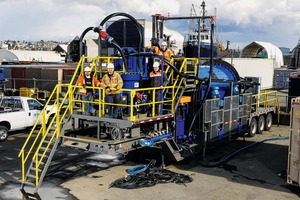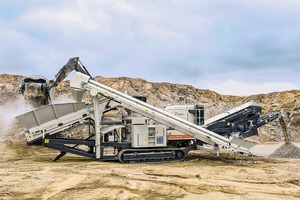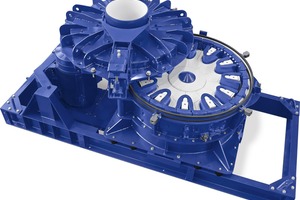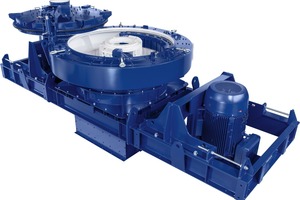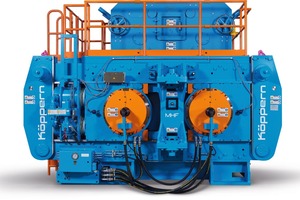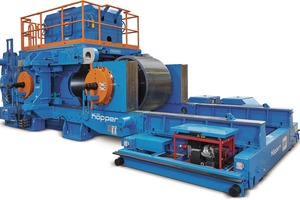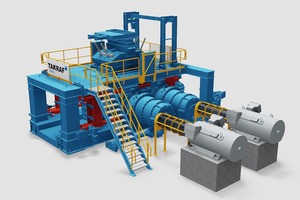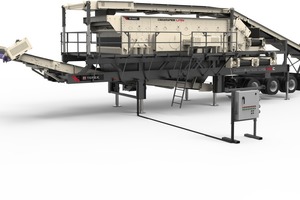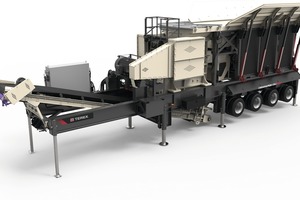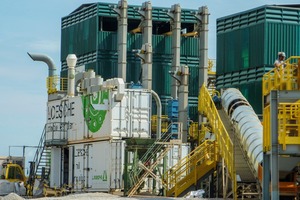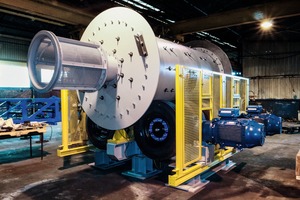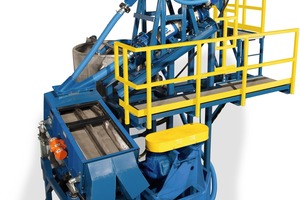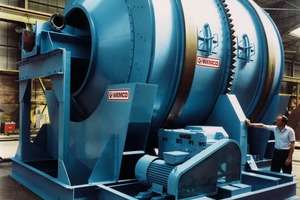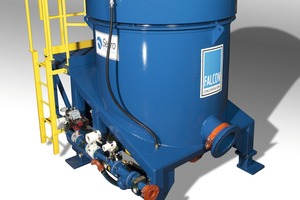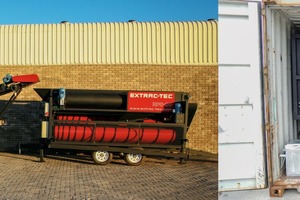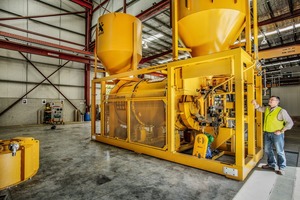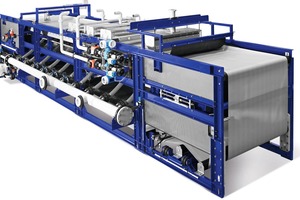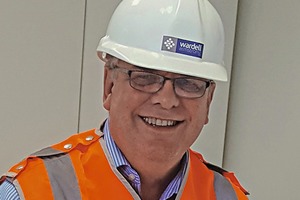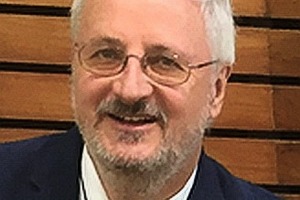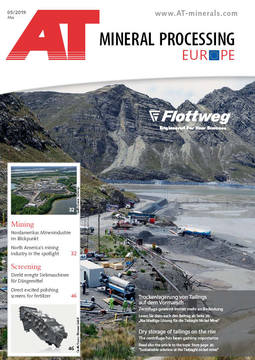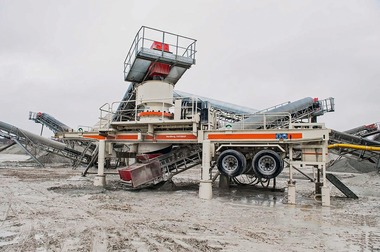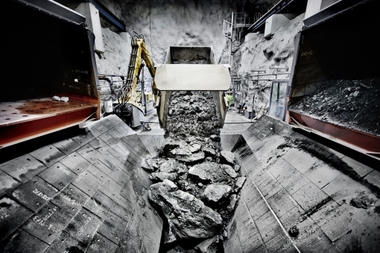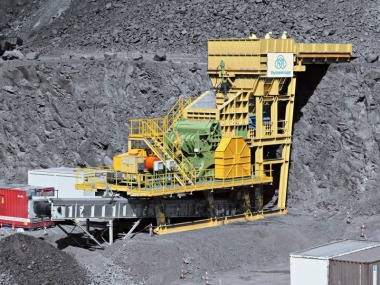Mobile Mineral Processing Equipment: The State of the Art (Part 2)
Summary: Part 2 of the report on mobile mineral processing equipment includes a description of typical processing equipment with focus given on European equipment suppliers and their corresponding mobile processing equipment for the specific process circuits – drawing upon worldwide practices.
4 Manufacturers of mobile equipment
4.1 Introduction
The vast majority of existing mobile processing equipment is used for crushing applications. However, there is a variety of other forms of comminution and beneficiation equipment that could easily be incorporated into a mobile plant and these are therefore reviewed in this Chapter. Examples of mobile processing equipment suppliers are summarised in Table 3.
4.2 Crushers
Mobile crushers have been identified as an “off the shelf” item of equipment that is already suited to the application of modular mobile processing. There are numerous designs suitable for an array of mineral applications. Considering there are a range of mobile crushing suppliers and that there is a considerable amount of technical knowhow in the design of these units, adapting them (if required) specifically for smaller throughputs or containerising them for transport is not envisaged as being an issue.
4.2.1 Atlas Copco
Swedish company Atlas Copco (AC) is currently manufacturing at approximately 100 sites worldwide. They employ around 44 000 people and sell a range of products such as compressors, generators, industrial tools and construction and mining equipment. Atlas Copco manufacture the mobile “Powercrusher” range which include jaw crushers, cone crushers, impact crushers and screening plants designed for quarrying and mining.
AC have patented a jaw crusher which incorporates a swing jaw which moves in a figure of eight motion that is said to increase throughput, minimise blockage and to produce a more uniform product. The mobile jaw crushers (models PC 1055, PC 2, PC 4 and PC 6) are powered by CAT engines and include pre-screening.
AC claim that their range of cone crushers (model PC 1000) can accept most sizes of feed including abrasive rocks.
According to AC, their range of impact crushers (models PC 1060, PC 1, PC 3, PC 1375, PC 5 and PC 1610) is adapted to both primary and secondary crushing of soft to medium hard material. They claim that the position of the swing beams which carry the hammers allow for a wider gap than other manufacturers (and thus a larger feed size), permitting their impact crushers to act as primary crushers for softer rock.
The mobile screens (models HCS 3715, HCS 5515, HCS 3D, HCS grizzly and HCS 1) can be operated in tandem with a mobile crusher or fed separately by a loader or excavator. All AC screens are vibrating screens.
4.2.2 FLSmidth
FLSmidth is a Danish company based in Copenhagen, employing around 15 000 people. The company offers two fully mobile products designed for mining use: The Dual Truck Mobile Sizer and the Triple Track Mobile Sizer. Unfortunately, the company gives no operational details of its equipment. They have supplied sizers to Goldcorp’s Peňasquitos gold mine in Mexico but there is little up-to-date news on either FLSmidth’s or Goldcorp’s web-sites.
FLSmidth also have a modular Reflux Classifier plant. This integrated engineered modular solution is based on the Ludowici REFLUX® classifier (RC) units which incorporate the ‘laminar high shear rate’ mechanism, a fine particle gravity based separation technology. Each section of the module is contained within the dimensions of a 20-foot shipping container. The combination of these sections or containers allows for the plant to be configured according to various and specific process requirements. The configuration is easily adjustable to accommodate the changing process or ore conditions within given parameters, and this offers enhanced flexibility. The dimensions of the unit and the modularity of the plant allow for easy relocations where needed, while rapid on-site installation is possible, as the frames of each modular section are easily assembled and locked together.
Plant components include tanks, FLSmidth Krebs® pumps, cyclones, Krebs Tech-Taylor valves, Technegate valves, the FLSmidth Ludowici vibrating screen, the Reflux Classifier and dewatering equipment, as well as the Meshcape Screen Media that comprises the polyurethane screen panels.
The modular RC solution is good for where the quantities do not justify the building of a dedicated fixed plant. The modular format allows a short-term treatment plant of capacities around 100 t/h to be set up without disrupting any existing process facilities. At the same time, the modular format can even be expanded for customers who want production capacity up to 400 to 600 t/h although these plants are more likely to a fixed solution.
4.2.3 Joy Global
Joy Global Inc. are an American multinational company headquartered in Milwaukee. They control the popular mining brands of Joy and P&H. Although Joy is not a European company they have European subsidiaries and are popular with European customers.
Joy Global manufacture a mobile crusher (model P&H 4170C) which is a heavy duty tracked mobile crusher designed to be loaded by face shovels. It comprises an apron feeder, a double roll crusher and a discharge conveyor. Unusually for mobile crushers, it can be equipped with a rock breaker hammer. It can handle 9000 t/h (nominal) and produces a finished product size of 360 – 400 mm. The machine is a primary crushing application and would normally require some sort of secondary crushing for some materials. It is widely used in coal mining.
4.2.4 Metso
Metso is a global company based in Finland, and employs 16 000 people world-wide. For many within the mining sector, they are the world leaders in manufacturing mineral processing equipment. Metso are strong advocates of the in-pit crushing and conveying (IPCC) system and will compare it favourably against conventional truck haulage systems. In the Metso version, an excavator feeds directly into the bin of their Lokotrack mobile crushing plant and then carried by conveyor to the fixed secondary plant for further processing.
The Lokotrack jaw crusher range (models LT 150 E, LT 160 E and LT 200 E) is designed to be used with the Lokolink conveyor system and is a primary crusher for hard rock and recycle products.
The Metso cone crushers (models LT 200 D, LT 330 D, LT 200 HP, LT 300 HP, LT 300 GP and LT 550 GP) are designed for secondary crusher and screening applications, and can produce up to three end products (Fig. 5). Some of the models are designed for multistage crushing.
Metso’s range of impact crushers (models LT 1110, LT 1213, LT 1213 S, LT 1315, LT 1415, LT 1418 E and LT 1620 E) is designed for softer rock such as limestone, and for asphalt and concrete crushing. Some of the models are designed for multistage crushing. The vertical shaft impactor (VSI) is designed to produce aggregates and sand from softer rocks, and can be used as tertiary stage in a multistage crushing process (models LT 7150 and LT 9100 E).
Metso’s mobile screens (models ST 2.4, ST 2.8, ST 3.5, ST 3.8, ST 4.8 and ST 620) can be operated in tandem with a mobile crusher and are designed for heavy duty pre-screening and recycling.
4.2.5 Sandvik
The Sandvik Group are a large Swedish company employing around 47 000 people. It provides equipment and tools for heavy engineering, construction and mining applications.
Sandvik manufacture a variety of both tracked (models QJ341, QJ331, QJ241, QJ21, UJ440i, UJ440E, UJ540 and UJ640) and wheeled mobile crushers (models UJ310, UJ210 and UJ300). The QJ341 is their best-selling model of the range of mobile crushers. Although they have mining applications, Sandvik also aim their products at the quarry, civils and recycling markets.
Sandvik manufactures also a wide range of trackmounted cone crushers (models QH331, QS331, QS441, UH440i, US440i, UH640, UH450E, UH440E, US440E, UD440E and QH441) and wheelmounted cone crushers (models UH421, UH320, UH430E, UH311, UH310, UH316, US310, and US316). Sandvik wheeled crushers are designed for small scale quarry applications and are unlikely to be used in conventional mining except for civil engineering applications such as providing aggregate for concrete or stemming for blasting.
Two mobile impact crushers (models Q1441 and Q1341) are available from Sandvik and these are both tracked equipment. The machines are designed for secondary and tertiary crushing and are used in quarries.
The Sandvik screens are standalone plants or are bolted on to jaw and cone crushers. They are one, two or three deck models. QA451 is a triple deck screen that is normally used in conjunction with a jaw or cone crusher, QA140 and QA331 are single screens and QA441 is a double screen.
4.2.6 thyssenkrupp
ThyssenKrupp is a diversified industrial group based in Germany with around 155 000 employees in nearly 80 countries. The company produces a range of mobile and semi-mobile crushers up to 14 000t/h. These appear to be bespoke machines fabricated on a client by client basis.
4.2.7 Wirtgen Group
The Wirtgen Group employs around 8200 people (2017), and is located in Windhagen/Germany. They have sales and services worldwide through several subsidiaries supplying the construction and mining industries. Their subsidiaries that produce mobile processing equipment are Wirtgen (continuous miners: models 2200 SM, 2500 SM and 4200 SM) and Kleemann (jaw, impact and cone mobile crushers and mobile screens)
Kleemann’s jaw crusher range includes the models MC 100 R, MC 110 R EVO, MC 120 Z, MC 125 Z, MC 140 Z and MC 160 PRR. The actual feed size is less than the inlet dimensions.
Kleemann advertise mobile cone crushers (models MCO 9, MCO 9 S, MCO 11, MCO 11 S, MCO 13 and MCO 13 S) as secondary crushers, principally for asphalt aggregate and concrete products, although they do have applications in other areas. In mining they tend to be operated in tandem with mobile jaw crushers as the primary crusher. Kleemann sell and rent the MOBICONE range, which also counts among the mobile cone crushers. The “S” range has additional screening – the models MCO 11 S and MCO 13 S have triple-deck screening allowing for three products to be generated.
The MOBIFOX range of impact crushers (models MF 12 S, MF 14 S and MF 16 S) is designed for soft to medium-hard stone, and like their cone crushers, are supplied with or without screens. The additional SNH series is designed with a “grinding path” to allow the shaping of regular cuboid grains, important for concrete or asphalt production. Kleemann cite its range of impact crushers as having a very fuel-efficient diesel/electric drive system capable of meeting stringent noise regulations.
Kleemann make a distinction between their contractor (general purpose) groups and their mining and quarrying machines (models MS 12 Z, MS 13 Z, MS 14 Z, MS 15 Z, MS 16 Z, MS 16 D, MS 19 Z, MS 21 Z, MS 20 D, MS 23 D and MS 19 D). Kleemann screens can be adapted as double-or triple deck screens, with or without a feed hopper, or as a banana or other types of screen. Kleemann mining and quarrying screens are of two types: Coarse screening plants (models MS 18 Z and MS 20 Z) and triple-deck screening for finer fractions (models MS 20 D and MS 23 D).
4.2.8 BHS-Sonthofen GmbH
The company BHS-Sonthofen from Sonthofen/Germany supplies mixing technologies (mixers), crushing technologies (impact mills, impact crushers) and filtration technologies for mining industry. Their vertical-shaft impact mills (BHS Rotor Impact Mill) is a potential solutions where selective crushing processes are required. This innovative processing technology is reportedly a cost-effective alternative to the enrichment of ores or industrial minerals during the initial stages of processing.
The BHS Rotor Impact Mill is a high-performance crusher with a vertical shaft. The rotor impact mill enables customers to achieve a high reduction ratio and excellent particle shape. The mill (Fig. 6) is suitable for crushing all low to moderately abrasive mineral.
BHS-Sonthofen offers also Rotor Centrifugal Crusher (Fig. 7). This rotor centrifugal crusher (type RSMX) is a high-performance crusher with a vertical shaft for throughput rates of 30 – 400 t/h, depending on the model. It is suitable for all types of minerals, including extremely hard input materials. Every single particle of the input material undergoes extreme acceleration in the patented twin-chamber rotor and is subsequently thrown against the fixed impact wall. The impact wall can consist of an anvil ring or a rock shelf. The ample size of the rotor and housing largely eliminates the risk of clogging.
The rotor impact mills (type RPM) and rotor centrifugal crushers (type RSMX) use a combination of impact and shear forces. These kinds of forces provide an excellent way of selectively crushing composite materials. Reportedly, minerals can be liberated from the surrounding waste rock using these machines.
4.2.9 Maschinenfabrik Köppern GmbH & Co. KG
Maschinenfabrik Köppern focus on briquetting, compacting and crushing of ore and is a specialist in high-pressure comminution. In the area of comminution of ore, Köppern has developed the high-pressure grinding roll (HPGR, Fig. 8). The HPGR is emerging as an important comminution technology in the minerals processing industry (Fig. 9). In direct competition with grinding by semi-autogenous tumbling mills (SAG) and ball mills (BM), the technology has found its key application in primary comminution and also in the liberation of diamonds. Compared with SAG and ball milling, the HPGR process can consume significantly less energy, which in turn leads to a reduction in operational costs coupled with a positive environmental effect.
Potential benefits of HPGR in comparison to conventional crushing/grinding:
Economic advantages
Short-term availability of equipment
Shorter installation commissioning time
Steady process throughput and the ability to adjust process parameters to changing ore properties
No pebble crushing
Reliable test work and scale up
The following products are also offered: roller presses, separator, fine bed roller mills.
4.2.10 TAKRAF
TARAF is a supplier of equipment for open pit mining and bulk material handling. TAKRAF’s range of products comprises High Pressure Grinding Rolls (HPGR), - Delkor Apic Jigs, DELKOR BQR Flotation Cells, Roll Crushers and fully mobile crushing plants.
High Pressure Grinding Rolls (HPGR) are modern and efficient comminution machines (Fig. 10). Grinding of material in HPGRs has proven to be more cost efficient as compared to conventional mills and crushers. Especially downstream processing stages such as ball milling are more energy efficient due to the finer product size distribution coming out of the HPGR and the additional effect of micro cracks in the HPGR product particles.
4.2.11 Terex
Terex Corporation is one of the global manufacturers of lifting and material processing equipment, serving a broad range of industries. Included within this is Terex Minerals Processing Systems, who supply a range of crushing and screening equipment for the minerals industry. The product line is dominated by jaw crushers, cone crushers, vertical/horizontal shaft impactors, and screening equipment (Fig. 11). The size reduction and screening technologies are well proven and have been employed for mineral processing operations around the world.
This equipment comes in a variety of sizes, suitable for treating a range of throughputs and applications. For example, the unit pictured in Fig. 12 can process ore at a feed rate up to 1180 t/h. The equipment can additionally be supplied in a modular or mobile format. These units come pre-built and pre-wired, and require a small footprint with a limited civil engineering, allowing straightforward on-site assembly.
Powerscreen is a UK based company, owned by Terex. Powerscreen designs and manufactures mobile crushing equipment. The range includes jaw, impact, and cone crushers. The smallest jaw crusher unit is the Metrotrak which is a track mobile jaw crushing plant which includes feed hopper, grizzly feeder, jaw crusher, dust suppression and product conveyor. This is capable of treating up to 200 t/h.
The impact crusher range is for shaping applications including making chips, sand, concrete manufacture, and glass recycling. The range includes both horizontal and vertical impact crushers. This is also track mounted.
Powerscreen produces various tracked cone crushers and tracked screening plants. The smallest cone crusher 1000SR has a throughput of up to 230 t/h and includes a cone crusher, feeder, metal detector and dust suppression and double deck post screen.
4.2.12 Parker Plant
Parker Plant is a U.K. company which supplies crushing and screening plants for primary, secondary and tertiary applications. Parker’s range of crushing equipment and vibrating screens are available in any configuration of tracked, wheeled or static unit.
Parker offer a range of tracked primary jaw crushers that can be quickly and easily put to work or moved from one location to another. They also have tracked cones which are designed either as stand alone crushers or for integration with other tracked machines from the Parker Range. The range of Parker tracked high performance HD series impactors are designed to suit medium to high volume primary and secondary crushing duties. Parker also has a range of tracked double deck and triple deck inclined screens.
Parker offers simple solutions to mobile crushing & screening challenges. The CrushRanger & Hunter outfits are easily transported and can be operational within hours of being on-site. The Hunter is a simple self-contained jaw-crushing unit that incorporates a rotary screen & feed platform. The CrushRanger models available are two stage, closed-circuit arrangements with jaw, cone, rolls crusher and screen options mounted on one chassis.
4.2.13 Hewitt Robins
Hewitt Robins International Ltd, based in the U.K., supplies mobile screens on tracks, wheels or skid mounted frames to allow customers to move their screens around with ease. The mobile range is available as inclined, horizontal or high energy screens and in multi-deck configurations (dimensions up to 1.8 m in width to 7.2 m in length). The Hewitt Robins Mobile Crushers are designed for instant set-up, featuring hydraulic support legs, folding feed hopper and a conveyor belt.
4.3 Grinding
Mobile grinding circuits do not predominately feature in the minerals industry and adaption of existing equipment is likely to be the cheapest and most robust option.
Loesche is a Düsseldorf based company developing grinding and mineral process technologies. It originally produced a mobile grinding mill as well as grinding mills installed in plants in 1928 and has developed the concept further since then. It is not a mobile plant in the true sense of the word, mounted on tracks or wheels. Instead it comes in three or more 40-foot containers with the actual plant in two containers, and the control room in the third (Fig. 13).
The plant consists of a vertical roller mill that comminutes the relatively dry ore. According to the company, the plant, called the OGP (Ore Grinding Plant) mobile, has the following advantages:
Reduced operating and capital costs
Lower energy consumption
Higher output level
Adaption to rapid changes in metallurgy
Reduced or no water consumption
Can be automated
It can grind down to 90 μm. The weight of the full equipment is 65 t, requiring a couple of trucks, and uses electrical power (420 kW). Output is limited to between 2 – 4 t/h of soft rock; the OGPmobile’s primary use is in the preparation of gold ore/iron ore etc.
The Sepro mill used together with of existing equipment is considered as a preferred option as these are used in industrial plants and have a proven track record. As an example, a unit such as the wheel-mounted Sepro Tyre Drive Mill (Fig. 14) supplied by Sepro Mineral Systems Corp. is a unit that could be potentially adapted and integrated into a modular mobile grinding circuit.
This type of grinding mill would be a potential candidate for a modular mobile circuit as it is suited for small capacity applications. The Sepro unit also has a variable frequency drive (VFD) system that allows the operator to fine tune the operation to suite the mining application. The unit would also be suited for regrinding duty. The mill has been designed so that either ball, rod or pebble charges can be used.
4.4 Pre-concentration technology
Pre-concentration technology could be a significant and important aspect in developing mobile processing systems. The technology gives the opportunity to be able to reject significant quantities of material prior to beneficiation. The benefit therefore is that the physical size of the beneficiation circuit can be reduced thus making potential capital and operating cost savings, thereby increasing the economic viability of Projects. Pre-concertation technology could also potentially be located underground and could therefore reduce haulage costs and decrease the operating cost of tailings disposal if a coarse reject can be deposited underground.
There are a variety of technologies available, such as dense medium separation, optical and X-ray sorting, which will be described in more detail below. Dense medium separators have been extensively used in the mineral industry where as sorting based separators have only recently become available to mineral applications following technological developments.
4.4.1 Dense medium separation
Dense Medium Separation (DMS), also known as Heavy Medium Separation, is a process where a suspension of dense powder in water is used to form a type of ‘heavier liquid’ to separate mineral particles in a sink-float process. Many modern dense media plants use this technology because it is both flexible and allows upgrading of resources thereby increasing overall profitability of the resource. The correct application of the DMS technology can increase the recovery of minerals and diamonds and increase the separation efficiency of the scrap metal recycling process. Ferrosilicon powder (for higher density separations) or magnetite-based medium (for coal applications) is commonly used to adjust the density of the medium.
Dynamic dense media separators
Sepro Mineral Systems supplies customizable and transportable Dense Medium Separator Plants for a wide variety of application requirements. As an example, Sepro manufacture the dynamic, multi-stage Condor Dense Medium Separator (DMS). This unit has a minimum of two separation stages which is claimed to result in high product separation efficiency in rougher/scavenger or rougher/cleaner dense medium multi-product applications.
Sepro’s standard two product (concentrate, tailings) Dense Medium Separator Plant utilizes a two stage Condor DMS (Fig. 15) and single density medium circuit, while the three product (concentrate, middlings, tailings) Dense Medium Separation Plant utilizes a three stage Condor DMS and two medium circuits at high and low density.
Drum dense media separator
As an example of these types of separators, FLSmidth supply the Wemco® Heavy Media Separation. These are modular, relocatable and mobile available with either Drum or Cyclone modules. The WEMCO Heavy Media Drum Separator is a dense media separation for coal and minerals in the size range of 300 – 6 mm. An example of the Wemco® Heavy Media Separation is shown in Fig. 16.
Krebs Heavy Media cyclones are also supplied by FLSmidth and these are designed specifically to pre-concentrate coal and minerals, using dense media.
4.4.2 Optical and X-Ray Sorters
Optical or digital sorters use cameras and/or lasers to sort material based on size, shape, colour or other physical properties (e.g. chemical composition). They are largely used in food processing and are being introduced to mineral processing. X-ray sorters are being developed and separate minerals by distinguishing differences in their physical and structural characteristics.
Metso report that the Australian Commonwealth Scientific and Industrial Research Organisation (CSIRO) is developing a bulk ore sensor using magnetic resonance that could potentially detect the grade of ores, and so separate ore from waste.
As an example, Mogensen manufacturers optical sorters. In these sorters a vibratory feeder ensures that the material arrives in an even layer on a chute. The material is then accelerated and is scanned as it falls past several high-resolution cameras. The images are examined by a computer and a stream of compressed air ejects the undesired particle from the material flow.
To allow the system to work certain conditions must be met:
The materials must be easily differentiated by colour or brightness. It means that the material must be washed beforehand.
It has to be fed in narrow size ranges of 3 – 250 mm.
It must be possible to ‘treat’ a single particle.
As a result, Mogensen sorters have applications in separating clay types (based on colour), high-quality refractory bricks; and detecting impurities in some minerals such as andalusite, cristobalite and feldspar-quartz mixes. Although applications in mining are limited, technological advances will render several advantages:
They achieve stable and consistent results on certain materials where sorting by colour and brightness is possible.
Low cost and low maintenance.
It is environmentally friendly.
The company makes a range of sorting machines. The largest machines can handle a maximum of 10 t/h and are advertised as suitable for mining applications. The largest, the MSORT AG/AH, can treat particle sizes between 80 – 250 mm.
Notably, Steinert have recently supplied a mobile containerised X-ray and induction combination ore sorter (available via Ore Sorting Australia Pty Ltd). This piece of equipment comes integrated with the required compressors and diesel generator to facilitate operation in any location.
Schaefer Kalk GmbH is based in Diez/Germany, and installed two optical sorters at Steeden limestone to process 120 - 150 t/h with a 30 % rejection rate. The machines, a Redwave sorter from the Austrian company BT-Wolfgang Binder GmbH, were installed in 2011 and have been continuously improved during operations. The limestone produced at Steeden has large variations in colour and chemical composition allowing for effective separation.
Redwave sorters (Schaefer Kalk GmbH) are a mix of optical and X-Ray sorters that can work on most metals according to the company’s website. Although they might have some mining applications, they are largely used in scrap metal, waste and ceramics. None of their machines appear mobile. Nonetheless, the development for mining appears promising and if an optical/X-Ray process can determine ore grade in a heterogeneous rock mix, then it could help revolutionise minerals processing. It would have the potential to reduce costs and be far more environmentally friendly and sustainable than current processing methods that can be profligate in the use of energy and water.
4.5 Beneficiation
Beneficiation equipment tends to be used for stationary installations. However, adaption of these technologies could be undertaken for the purpose of making them mobile. Although not all equipment described in the proceeding chapters are intended for mobile applications, it is envisaged that they could easily be adapted accordingly. Therefore, these are included in the review.
4.5.1 Gravity
Centrifugal separators such as the Knelson and Falcon concentrators (Fig. 17) are often found in stationary plants to recover liberated gold ahead of cyanide leaching circuits. The units have a small footprint and can be used to concentrate a variety of minerals. These units could potentially be used in a mobile setting and therefore serve as an “off the shelf” item subject to suitability (as defined by metallurgical research). Throughputs range from 1 – 1000 t/h.
Jigs and shaking tables are also other gravity technologies that are identified for the recovery of minerals containing metals such as gold, tungsten and tin in a mobile processing environment.
Mobile gravity plants (“Wash Plants”) are commonly used in alluvial gold operations. There are a variety of manufacturers who supply equipment to the industry, most them use trommel screens and sluices in their processes.
As an example, a unit such as the HPC-30 (Fig. 18) supplied by Extrac-Tec, SA, is a unit that could be used and integrated into a modular processing flowsheet. This unit uses both trommel screens and sluices but also incorporates a patented system whereby the washed ore is initially concentrated by a dynamic fluidised bed prior to the use of riffles. The manufacturers of the HPC-30 unit also claim that it is suitable for a broad range of heavy particle concentration applications including gravity concentration of minerals such as cassiterite, malachite, galena, garnets and silver. The unit is offered with a choice of feed systems to accommodate a broad range of applications, sites and operating conditions. This innovative design (dynamic fluidised bed) allows increased throughput to be achieved and highlights how conventional technology could be enhanced to fulfil the objectives of FAME. Also of interest is that the unit can be containerised for the purpose of transportation.
4.5.2 Leaching technology
Agitated leaching is often performed on ground ores which are added to a mixing tank with water and an extractant (such as cyanide or acid) to recover the metal of interest. The pulp is mixed for a pre-determined time to allow the metal to be extracted from the solid to the liquid phase. The liquid phase (having been separated from the solids), containing the metal is then further processed to recover the metal. One of the primary design factors is the correct choice of the necessary residence time, which can be up to 12 – 36 hours. The volume of the tanks required is therefore dependant on the feed rate to the plant and the residence time required. Consequently, there will be a limit on the size of agitated tanks that can be practically used for mobile processing. The selection of tank leaching will therefore be project specific.
Alternatively, In-Line Reactors (ILR) are units commonly used in gold gravity circuits to recover gold from gravity concentrates, typically generated from centrifugal concentrators. These units are continuous intensive leach reactors and the concept could be potentially developed where hydrometallurgical treatment of an ore or concentrate is required within a small footprint (relative to standard leaching tanks). Gekko’s ILR unit is shown in Fig. 19.
Consep, another Australian supplier of specialized processing equipment, has had significant success with its Acacia system, a packaged processing plant for treating high-grade gravity gold concentrates, such as those generated from a Knelson Concentrator. The Consep approach involves production of a concentrate from ore that undergoes intensive cyanide leaching in a closed-circuit system. The plant is built around an upflow fluidised reactor for leaching, designed to produce proper solid-liquid interaction for maximized gold leaching reaction kinetics without mechanical agitation.
4.5.3 Froth Flotation
Froth flotation cells are manufactured by a variety of suppliers. The size of the cell chosen for a project is dependent on feed rates and residence times required, consequently there are a variety of cell sizes offered by the manufacturers. Designs vary between the manufacturers but all share the common methods of separation. The main suppliers in Europe are Metso, FLSmidth and Outotec. Metso have developed a mobile processing plant (part 3, as follows), however equipment supplied from other vendors could be used to construct similar plants.
4.5.4 Magnetic and electrostatic separation
Magnetic and electrostatic separators are use used in applications where minerals can be separated using differences in magnetic and electrostatic properties. There are numerous types of these separators that are designed for specific applications. Eriez Magnetics Europe Ltd, supply a wide range of magnetic units to the mineral industry. The inclusion of these technologies into a mobile plant is not seen as being challenging.
4.6 Dewatering and auxiliary equipment
There are numerous equipment suppliers who supply dewatering technology and auxiliary equipment to the minerals industry. Dewatering equipment is used for the removal of solutions from solids primarily using thickeners and filters. High-rate thickeners, such as units supplied by FLSmidth, is an example where a unit more suited to mobile processing (having a smaller footprint, less energy consumption) than conventional thickening technology. Another example are lamella thickeners which often are used in the minerals industry (as part of water treatment circuits) and have considerably smaller footprint compared to conventional thickeners.
There is an array of auxiliary equipment used in mineral processing circuits, examples include:
Reagent and slurry pumps
Screens and cyclones
Tanks and stirrers
Air supply systems
Sensors for automation and control purposes
Piping and valves
Europe has a variety of manufacturers who supply these equipment items. One such examples is a belt filter supplied by BHS-Sonthofen (Fig. 20).
Nicht-europäische Hersteller sind blau markiert • Blue highlighted text refers to non-European manufacturers
*Es sind Einheiten vorgesehen, die sich ohne Weiteres an die mobile Aufbereitung anpassen lassen • Units foreseen as being readily adaptable to mobile processing
**Optische und Röntgen-Sortiermaschinen sowie Schwertrübetrennung • Optical and X-Ray Sorters and Dense Media Separation

